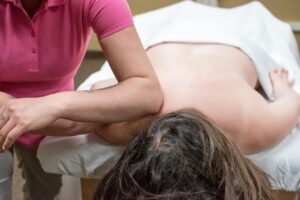The Outlook for MTs is Promising but…
The outlook for massage therapists is looking very good, according to the U.S. Bureau of Labor Statistics. The number of available jobs for MTs is expected to grow by 32% during this decade, which is considered to be “much faster” than most professions.

That’s good news! It’s unclear if this includes MTs that are contractors or otherwise self-employed. Probably not, since it focuses on “employment” – i.e. jobs where you’re working for someone else.
Regardless of how inclusive the data is, it’s still a clear sign that the demand for massage therapy will only continue to increase by leaps and bounds.
That makes sense, as we see more doctor referrals, more sports teams hiring MTs, more people that understand the benefits of massage therapy, more franchise MT locations, and much more stress in the world.
The Problem
The paradox is that the number of MTs available to fulfill this increased demand is going down. While this can manifest as excellent job security for those who do massage therapy, it doesn’t do much for the increased numbers of people wanting bodywork.
One problem is that there are less massage schools in the country now than there were 10 years ago. In 2010, there were 1440 massage school programs. Now, there are around 300 or so.
Most of this decline was due to changes in accreditation standards, economic issues, and other factors that were present long before the pandemic. Covid certainly didn’t help matters for massage schools.
Another factor that affects the numbers of available MTs is that many only work about one to three years before switching to other professions.
Some of this is due to overwork causing physical discomfort, low pay with some employers, and high amounts of school debt, requiring more income than many entry-level therapists can bring in.
Add to that the issue of working on clients during a pandemic. Many therapists have “retired” early or just left the profession to stay home with children or focus on other activities.
Many of the self-employed therapists I know spend more time telling people they can’t take on more clients than they do scheduling sessions.
Apprenticeship Law
In Arkansas, the legislature passed a law last year (HB1875 which was signed into law as Act 811) to allow employers to pay workers while they learn on the job.
This generic “apprenticeship” authorization went into effect January 1st. A separate bill to do the same specifically for massage therapy, coupled with mandates for online entry-level instruction, did not pass.
It’s unclear how Act 811 will affect the MT profession. Ironically, it exempts the cosmetology profession, but not massage therapy.
According to this law, the Department of Health would have to create rules to specify how apprenticeship will work. I don’t know if this process has already started at DoH or not.
One thing I do know is that the therapists who are working on clients will always need to keep up their skills, learn new ones, get CEUs to renew their licenses, and revitalize their practice. I can help with that.
Ray of Light Training CE Classes
We’ve got five CE classes coming up during Winter and Spring. To get more information about these classes and to register, click here to see the class schedule and reserve your spot. You can also call me at 800-584-1562.
Some classes are already more than half full, so it’s good to register early.
We start with two Direct-Indirect Technique (DIT) trainings in Fayetteville (Upper and Lower Back and Legs) and Jonesboro (Shoulder, Arm, Neck, TMJ).
These are followed by Muscle Balancing and Joint Stabilization in Hot Springs, Cranial-Sacral Therapy in Fayetteville, and Muscle Anatomy and Assessment Skills in Little Rock.
Each of these trainings offers 18-CEUs approved by the Arkansas Department of Health and the National Certification Board (NCBTMB). I hope I’ll see you in class soon.
Stay well and stay warm,
John
John Joseph Ray
Ray of Light Training
John is a Board Approved Continuing Education Provider through the NCBTMB
Member of the Fascia Research Society
